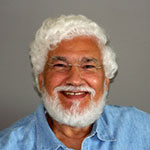May 29, 2016
Anna Boghiguian: From Egypt with Love
Six years ago on, one of my frequent visits to my native country, I was browsing in a large downtown Cairo bookstore. I had just picked up an English-language art book about Egypt and was leafing through the pages. After a few moments I realized that a woman nearby was looking at me and the book in my hand. Not a word was exchanged, but I kept looking at the book, then at her, and back at the book again.
Finally, I ventured to ask in English, "Are you the author of this book?"
"Yes," she answered in perfect Arabic, smiling. I immediately bought the book and asked her to sign it. After she did so, we chatted pleasantly and parted ways.
It was a delightful encounter for me, but sad as well.
I felt badly that neither Egyptian nor Canadian media seemed interested in the education, career, travel, writings and paintings of this genius artist.
The lady was Anna Boghiguian, one of Egypt’s foremost contemporary artists. Anna has traveled the globe and recorded her impressions of each new place she encounters in drawings and paintings that fill the sketchbooks she carries everywhere.
She was born in 1946 to Armenian Diaspora parents who’d settled in Cairo. After graduating in 1969 from Cairo’s American University in Economics and Political Science, she studied art under Egyptian teacher Fouad Kamel and then went on to obtain a Bachelor of Fine Arts degree in visual arts and music from Concordia University of Montreal, Canada.
Anna has been featured in many exhibitions in Egypt, Canada, Yemen, France, and Greece.
She has also illustrated many books, including editions of Ungaretti and Cavafy for the French publisher Fata Morgana. In 2000 the same publisher released her own book, Images of the Nile – part of a projected series on great rivers of the world, which will include volumes on the Ganges and Mekong.
For the American University in Cairo Press, she has illustrated Farewell to Alexandria by Harry E. Tzalas (2000) and created a series of twenty covers for English-language editions of novels by Egyptian Nobel Laureate in Literature, Naguib Mahfouz.
Boghiguian’s drawings and paintings are often influenced by multidisciplinary experiments that explore relationships between image and sound. During the late 1960s, for example, she composed musical works based on sounds of the city and then translated them into paintings.
She has participated in several biennials, including Thessaloniki (2007), Istanbul (2009), Sao Paulo and Cartagena (2014), Documenta 13, Kassel 2012, and Here and Elsewhere at New York’s New Museum (2014).
In 2013 Anna Boghiguian was commissioned to create a multi-media installation for the exhibition Tagore's Universal Allegories. The resulting work, A Play to Play, was inspired by Tagore's stage drama, The Post Office.
The book I happened to be holding when we first met in that Cairo bookshop, is her 2003 Anna’s Egypt: An Artist’s Journey.
Boghiguian’s world travels, whether through India or Cambodia, Canada or France, always return to Egypt, the land of her birth.
In Anna’s Egypt, her drawings reflect instinctive and emotional responses to this country’s many layers of history and legend, as well as to the people themselves, ancient and modern, powerful and ordinary, who populate her stories with such entrancing spirit.
In this very personal presentation, dedicated to her parents and "everyone I have met in Egypt," Boghiguian shares her love of this incredible land in visual and verbal thoughts as she leads us on a tour of fact and fiction, across space and time, using words and images to tell its stories. The 136 pages include 120 drawings in black and white, while the cover features one of her paintings in color.
Not surprisingly, half of Anna’s Egypt is devoted to Cairo. But she also does fine justice to Alexandria, Luxor, Aswan, Port Said and the Red Sea, as well as to Egypt's oases, especially the lovely Siwa.
In her chapter on Cairo, Boghiguian takes the reader on a memorable tour of her birth city, past, present and imagined into the future. She writes lovingly about the diversity of neighborhoods in this vast sprawling metropolis, from wide modern streets to crowded alleyways where vendors compete loudly for buyers.
Here is one of many examples where Anna Boghiguian’s musical prose will entrance even readers with no experience at all of Egypt:
"Centuries have passed on the silent desert. Many footsteps have crossed the sands. History tells many tales of travelers, and heroic travel epics are sung in coffeehouses. One crosses the sand, the mountains, and rivers: the same epic text takes different forms, suited to the geography of that land. When it reaches Egypt, it meets layers of time, and history turns into pages, into books as intimate as the thousands of coffeehouses of Cairo, into images as vivid as paintings, painted by the travelers who came with influence and marked the country with their own vision of reality.
Those who sit in the coffeehouses come closer, through the smoke. Poems in the form of music are recited in honor of those who fell in love to create the city. As the breeze brings in dust and flies, the many passers-by are like the relics around: all have their tale and indispensable role; when one dies, the image is transformed into words or paint. The stories and images eventually become part of history."
I find, like so many others, that Anna’s Egypt is truly unique – a book that is as much about the artist as about her beloved land, and a treasure on both counts.
I feel so fortunate to have met Anna Boghiguian in person and to own a copy of her work.








